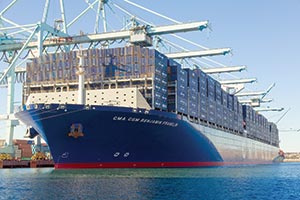Megaships Lucrative for Ocean Carriers, Challenging for Truckers, Ports, Panel Says

This story appears in the Jan. 16 print edition of Transport Topics.
WASHINGTON — Megaships are good economically and environmentally for ocean carriers, but they pose significant challenges for ports and trucking companies, according to a panel of experts at the 2017 Transportation Research Board conference here.
Neopanamax containerships hold nearly 13,000 industry-standard 20-foot-equivalent units, or TEUs, the maximum that can fit through the expanded Panama Canal. But megaships, as defined by the panelists, carry 18,000 TEUs or more, such as the 1,300-foot CMA CGM Benjamin Franklin, which arrived on the West Coast in early 2016.
For the ocean carriers, megaships can transport the same number of containers on one ship that previously would have required two or three ships, improving efficiency. The overall volume they can transport per year also increases, which is a boon financially.
“Our current goal, by 2020, is to reduce the CO2 per container, per kilometer by 60%,” said Lee Kindberg, Maersk Line director of environment and sustainability, referring to carbon dioxide. “That means we will use less than half the fuel and less than half the energy per container from 2007 to 2020.”
However, unloading more containers at once instead of spreading them out over several port calls puts additional strain on terminals and slows down the speed that cargo is transferred onto trucks, according to the panelists.
“The ports are spending more money for the same volume and the same revenue,” said Thomas Ward, senior maritime planner at Parsons Brinckerhoff, an engineering and consulting firm with a port, intermodal and maritime planning practice.
For example, he explained that it takes more equipment and resources to unload one 18,000-TEU containership than two 9,000s, even though the amount of cargo and revenue doesn’t change. The megaships require more storage area for the containers, bigger ship-to-shore cranes and bigger wharves to handle the longer ships, he said.
“The bigger ships mean higher operating costs and poorer terminal services for the same volume. It slows down gate service and makes trucking companies unhappy,” Ward said. “Serving bigger ships requires a substantial investment in equipment and terminal space for the same revenue. Ports choke on these bigger ships because any investment they make in servicing them generates a negative return on investment, which, when you take it to a bank, is usually not a good selling point.”
Slower terminal services, or throughput, causes longer lines for trucks, more waiting, lower efficiency during hours of service and less revenue, according to the panel.
“We’ve seen truck lines that were miles long,” said Gerald Coyle, a vice president at the Evans Network of Cos., which ranks No. 59 on the Transport Topics Top 100 list of for-hire carriers in the United States and Canada. “When you have hundreds and hundreds of trucks idling outside a gate, it’s a disaster.”
“Ground zero on terminal efficiency is the gate. I will totally agree on that issue being a big problem,” conceded Michael Christensen, senior executive for supply chain optimization at the Port of Long Beach, California. “We have to deal with gate queues, gate efficiency and turn times within the terminal. The hand-off to the truck is key, and that is something we worry about.”
Daniel Hackett, a marine industry consultant with Hackett Associates, said that port authorities and terminal operators are in a tough spot and must foot the bill to prevent delays, backups or other supply chain disruptions.
“If the steamship lines use the larger vessels, then the ports themselves don’t really have a choice. Ultimately, someone has to pay, and right now, it’s the ports,” he said.
The Port of Long Beach passed its first test in February 2016, when SSA Marine Inc. unloaded the CMA CGM Benjamin Franklin at the Pacific Container Terminal in 4½ days.
Randy Galosic, general manager of SSA Marine, believes that with the proper infrastructure, terminals can handle the extra load on a regular basis and it would be a net positive to all sides. SSA Marine routinely handles 10,000 to 13,000 TEU vessels, he added.
“These big vessels are only 100 feet longer than the ones we are working on today. We feel that we will be able to handle them in Southern California,” Galosic said. “Our job is to find a way to be prepared to handle them or we have the potential of losing out on the business.”
Currently, only 13% of the worldwide containership fleet is larger than 13,300 TEUs, but 49% of the ship builds in 2016 were that size, according to Alphaliner. The group also reported last April that 59% of ship orders were 13,300 TEUs or larger. So while the Benjamin Franklin remains the only megaship to visit the United States, it may not be too long before others arrive.
“We have opportunities here, as port authorities and every stakeholder in the supply chain, to actually make things better,” said Christensen. “I think the challenges with these megaships are things that we can and will meet.”




